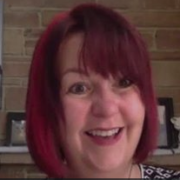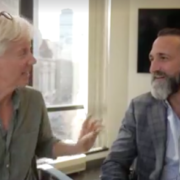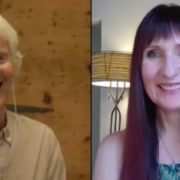158. Say What They Can’t Unhear with Tamsen Webster
OK, so you want to make a bigger difference. But how do you get people to pay attention, let alone remember what you have to say, long enough to be persuaded by your point of view?
If you’re a change maker then you know just how hard it can be to create lasting impact.
Well, this week’s guest, author & speaker, Tamsen Webster, is going to share her simple, actionable framework that will turbocharge your ability to create true believers in your vision.
Tamsen has a new book, “Say what they can’t unhear – 9 principles of lasting change” that makes unconventional ideas accessible and actionable for anyone seeking to build enduring buy-in and inspire meaningful, lasting change.
So, if you buy in to the school of thought that truly believes we can change the world, stay tuned!!
Episode Resources:
Episode 31. Make your big ideas irresistible with Tamsen Webster
Get Tamsen’s new book: “Say What They Can’t Unhear”
Download Tamsen’s free Guide: The Compact Case– a simple worksheet to help you follow the guidance of the book & develop your own case for change.
Free Guide: The Art of the 5-Minute Video – Here’s how you can present the methods, frameworks & systems that you’ve honed in a clear, concise and personable way – in 5 minutes or less.
Transcript:
Tamsen Webster:
the best way to build buy-in for belief is to build an argument based on what your audience has already bought into, and fundamentally, what that means is taking very familiar, intuitively agreeable things and putting them together in an unfamiliar way. But because this is about persuasion, my perspective and what I’ve seen work again and again is that we actually have to identify why they would agree in the first place not why we would agree, not why we think it’s a good idea, but why would they think it’s a good idea and then build up from there.
Brad Powell:
You’re a changemaker, you know how hard it can be to get people to buy in to your vision. You want to make a bigger difference, but how do you get people to pay attention, let alone remember what you have to say long enough to be persuaded by your point of view? Welcome to the Standout Business Show, where it’s all about making a bigger difference by doing business differently. I’m Brad Powell, and today I’ve invited author and speaker Tamsyn Webster to share her simple and actionable framework that will turbocharge your ability to create true believers in the change that you want to make. Tamsin has a new book out and it’s called Say what you Can’t Unhear, which are nine principles of lasting change, and these principles make unconventional ideas accessible and actionable for anyone who seeks to build enduring buy-in and inspire meaningful lasting change. Enduring buy-in and inspire meaningful lasting change. So if you buy into the school of thought that truly believes we can change the world, stay tuned and let’s start the show. Okay, Tamsen, welcome to the show.
Tamsen Webster:
Hello, hello. I’m delighted to be here.
Brad Powell:
Yeah, you know, show Hello, hello, I’m delighted to be here. Yeah, you know, we talked in an interview on this program a couple of years ago. It was way back in episode number 31. Oh, early, really early, and in fact you are one of the only people who’ve actually come on more than once.
Tamsen Webster:
Hey, hey, well, I’m honored. Thank you for having me back.
Brad Powell:
It’s so great. So last time we were talking about making your ideas irresistible, and today we’re really talking about something deeper, which is in the world of persuasion and shifting perspectives, and so when we just start entering this conversation, people have this idea that, oh, I have this new idea, this thing that I know is going to be awesome, and they run into the room, or whoever they’re talking to, and they go look, this is so great. And somewhere in the belief that, just simply, their enthusiasm is going to carry the day, and people will immediately go yeah, right, you’re totally, I get it, let’s go, and they’re going to jump on this bandwagon that you’ve built so endearingly for them, and usually that just doesn’t happen at all. So talk about this landscape. And why is that so hard to do?
Tamsen Webster:
Well, it’s hard to do for any number of reasons. I mean, you’ve got so much, so much of everything is working against you, and human wiring is working against you. Previous people’s previous experience is working against you, and I’d say one of the things that’s really prominent about working against you is that that, yes, getting people’s interest is important. Getting them to see that you’re excited about the idea that you believe in it is critically important. But if there’s not something beyond that interest that keeps them there, right, if they don’t see that interest, if that interest doesn’t sustain as relevance, if they don’t really understand what it is that you’re excited about or why they should be too, that’s going to be a problem.
Tamsen Webster:
And even if they are interested and they understand, then we’ve got this deeper problem of whether or not they agree and that both of those other pieces are what I find that we oftentimes just skip over, because we already understand our ideas, we already agree with the change that we’re asking people to make, and so we start from that perspective of, well, this is great, let me just tell you how to do it. And we forget that they start as skeptics, as newcomers to this idea, and so really, our job is as much education as it is influence and persuasion, particularly when the idea is new, and so that means we have to back up and think about some of these other pieces. So if it’s education, we need to make sure they understand it. But because this is about persuasion, my perspective and what I’ve seen work again and again is that we actually have to identify why they would agree in the first place Not why we would agree, not why we think it’s a good idea, but why would they think it’s a good idea and then build up from there.
Brad Powell:
Yeah, that’s so great. I mean, why would they agree? And I’ve been reading the reviews of your book. The book isn’t out yet. It’s coming soon yes, october 8th. I’ve been looking to say where can I get this? But anyway, what I was reading about was this thing that you’re talking about, where building an argument for your idea and starting in that place of agreement, starting with things that they either already agree or already believe. So talk about that part, because that’s a big thing that I think people just overlook.
Tamsen Webster:
Yeah, I mean because it’s counterintuitive. I mean, the counterintuitive part is we’re trying to do something new, so why would we start with things that they already believe? So, to understand that a little bit, we need to back up to, oftentimes, what gets in the way. So why does it make sense, at least intellectually or intuitively, to try to do something different? If we want somebody to do something different, it feels like, well, everything should be different, right, and there’s a name for that. It’s called cognitive inertia, which, like physical inertia, is the fact that we as humans, our thoughts, tend to stay at rest. Our stories we tell ourselves tend to stay at rest. Our behaviors tend to stay at rest, and so, when it comes to driving change, which is a movement, it feels like we need to move something or whatever’s getting in the way. The problem with that, the problem with getting people to do something new, to believe something new, to want something new, which fundamentally, I think is at the heart of a lot of what we do as leaders, as marketers, as salespeople, is that when we come back to cognitive inertia, it’s still the enemy. And here’s why, number one, if we try to introduce something new. Again, cognitive inertia exists the longer somebody has wanted something, typically the stronger they want it. The longer they’ve believed something, the stronger that belief tends to be, as in a new outcome, a new solution, a new offering, a new idea that it doesn’t actually permeate their awareness at all, because everything you know, generally they feel that what they’re doing right now is fine, right. If they don’t understand why they would want it, why would they pay attention to it? So that, right, there is one of the main reasons why, when I’m working with clients on designing these kinds of persuasive messages, the first place we already start is what question is your audience actively and knowingly asking? In other words, what is something that they already want and that they know they want, that your idea, you’re offering this change, will deliver for them. But from there it’s also about saying, well, okay, we can tell them that, but what’s going to make them believe it?
Tamsen Webster:
This comes back to cognitive inertia and those strong beliefs that already exist.
Tamsen Webster:
When we try to get someone to believe something new, it’s this like tiny baby infant of a belief in their system, right, and that’s assuming we’ve gotten them to at least nominally agree with it in the first place, which means the first time it comes up against a pre-existing version of that belief.
Tamsen Webster:
It’s basically this little, teeny, tiny baby belief fighting against this 800 pound gorilla of a belief, and generally it’s the older, stronger belief that’s going to win. So the approach that I take, and the approach that the book argues for, is that let’s use the strength of pre-existing beliefs. If those beliefs are hard to move, that’s that fine. Instead of trying to move the one that’s getting in the way, let’s go searching for another one that is just as strong or stronger, that’s already in their belief system, that supports this new idea, and let’s swap that into our argument, in our case, for change instead. So to sum that all up, basically what the whole kind of hypothesis of this book is that the best way to build buy-in for belief is to build an argument based on what your audience has already bought into, and fundamentally, what that means is taking very familiar, intuitively agreeable things and putting them together in an unfamiliar way.
Brad Powell:
Agreeable things and putting them together in an unfamiliar way. That’s so interesting because I have talked a lot about what I call myth busting as a way of persuading.
Tamsen Webster:
Yes.
Brad Powell:
Which is pretty different, in the sense of people have these pretty settled beliefs, belief systems that are based on conventional wisdom or something that they’ve been taught since childhood or whatever, and a lot of that information isn’t necessarily serving them all that well in the present. And so, as an agent of change, you come in and say well, I know that you would believe this thing, but actually it’s just a myth. Let me blow it up.
Brad Powell:
Yes, and what you’re talking about is something entirely different in terms of going into somebody’s belief system and saying, well, here’s something that I know you already know and think and believe, and and then moving them from that place of agreement. Yes.
Tamsen Webster:
Yeah, I mean. So there’s a couple of things with myth busting. I mean, in essence, something like that still has to happen, right, something does still have to get upset in their, in the way that they’re looking at things, in order for for the behavior to tip in a new direction. But with myth busting, there’s a couple of different things in play, right? One of them, and probably the primary one, is what I talk about as principle number four and that I frame as identity is the greatest influencer, and while that is universally true, right, how we see ourselves or how we want to be seen, drives the vast majority of what we do, personally, professionally, whatever, whether we want to realize it or not, that we, if we’re somebody who’s trying to get someone to engage in that way and to change, we need to remember that, because we need to remember, or at least imagine, what it might feel like to be on the other side of that myth busting experience. Now, sometimes that can be. If somebody is actively seeking to understand why something that they’re doing isn’t working, then they’re going to be very open to myth busting. But if they are not actively seeking, right, if they’re not, if they’re not understanding that, there is anything quote unquote wrong with what they’re doing now the myth busting is likely not going to work because it’s violating one of the most important and universal aspects of our identity and that is most humans, if not all humans, I can’t say that for sure but most humans want to be seen as smart, capable and good and in fact, our own self-concept is such that we really have a hard time accepting that we have in any way, shape or form behaved in a way currently, past or future that is not smart, capable and good. So in that framework, again, if somebody’s not unaware of the fact that maybe it’s something that they’re doing or thinking, that’s an issue.
Tamsen Webster:
If we go in with an attitude of myth busting and saying essentially, to some extent here’s why everything you believe to be true is wrong that that could work very strongly against you in those situations, because that person may feel like you’ve attacked their identity as a smart, capable, good person, and what that does is it creates what psychologists refer to as reactance, which is this initial resistance to what you’re saying.
Tamsen Webster:
So, again, it’s not that myth busting doesn’t always work. It’s just that we have to make sure that the person is in a frame of mind where they are looking to have a myth busted. Otherwise, we need to be thinking about how else can we approach the situation in such a way that they come to their own realization that not necessarily, not necessarily, excuse me, let me. Let me say that, again, it’s not that what they say isn’t true or right, or what they’ve been believing isn’t true or right. What we’re trying to get them to say is either it’s not true or serving them in this instance, or that there is something else that they believe to be true that is going to serve them better in this instance. But again, it really does keep going back to what is it that they already believe to be true, even if it’s in some other context?
Brad Powell:
Yeah right, that’s really good distinction there, and I just want to underline the smart, capable and good. We don’t we all want to feel that.
Tamsen Webster:
Yeah, I mean, and that’s the thing, it’s not that we necessarily all believe that we are, but we certainly want to be seen that way.
Tamsen Webster:
And it can be really transformative to your understanding of other people’s behaviors when you keep that in mind, when you say to yourself, because sometimes the initial reaction is like oh my gosh, how could they be so stupid? Oftentimes, as a phrase, we’re like that’s a bad person, that person’s evil, or those people are evil, or again, and it’s just, we use these things that suggest that they are not smart, capable and good and try to find implication that we are because we see the world the way that we do. But if you understand that again, they are operating by the same rules of being human that you are. In other words, we, you, we want to be seen as smart, capable and good. And then we go one step further and follow that curiosity and say, well, why would a smart, capable, good person do that? Like, what is it getting for them? What is it serving for them? Not only oftentimes do we have a wildly new understanding of oh my gosh, there is more than one way to look at this situation. I may not agree with it, but I can now understand it.
Tamsen Webster:
But second, and this is particularly important, if you are in fact trying to persuade someone or sell something new to them, if you understand why they’re doing what they’re doing now, or why a smart, capable, good person would do what they’re doing now or choose what they’re choosing now, then you may understand what is it that they are most afraid of losing by changing something right, because there is some kind of value coming to them from their current behavior, from their current choice, from their current partner, vendor, product, whatever. So what is that thing? Because understanding what that thing is that they’re getting from that can tell you either make sure that’s in whatever you’re offering, because they’re not going to give up that thing that they really value, or or, second, now, how can you, if that thing is in your thing, in you, in what you offer now you can make sure that that’s an aspect of what you’re offering that you can introduce into this understanding of what you’re offering and then essentially start to de risk the situation for them, because fundamentally it’s risk that gets in the way of change.
Tamsen Webster:
A lot of times people say fear, or even cognitive inertia or whatever, but it’s because anything else carries risk risk of loss, risk of exposure, risk of invalidation of your identity, but it’s risk aversion. Change aversion is risk aversion, and so, by really thinking through and understanding what is it that they consider to be at risk in whatever is going on, that can help make your presentation of whatever you’re talking about stronger, or it may even help you identify that you’re actually not for them, this is not the right answer for them, because they may value something that whatever you’re offering simply doesn’t deliver and you don’t intend for it to right, and that’s okay. You know, I work with enough salespeople to know that the faster we get to yes is great, but so is the faster we get to no, because we can also solve a lot of problems and save everyone a lot of time if we can get to know just as fast as we can get to yes.
Brad Powell:
Yeah Well, the thing about risk aversion reminds me. I was hearing a story recently and this is like a parable kind of story. I don’t know if it ever was true, but this guy’s walking down the street in a small town and there’s an old man in a rocking chair and a dog sitting on a porch and the dog is whimpering. And the guy says how come your dog’s whimpering? And the guy says, oh, he’s laying down on a nail. And the guy says, well, why doesn’t he get up? And he says, well, it would hurt too much. And the point was, you know, when you’re talking about risk aversion and an offer that you’re making, if the pain of the thing that the person is going through unless that’s stronger than the pain of actually curing the problem, they won’t do anything about it.
Tamsen Webster:
That’s true, that’s true, and that can also be a thing that gets in your way as well. So that’s so. That’s the sixth principle of the book, and that is that pain is the enemy of long-term change. And I am, in that chapter, yeah, fully transparent about this, going right after the, the kind of line of advice that’s been given, the conventional wisdom that says we need to make the pain of the status quo exceed the pain of change. If you are looking for action, then pain is your ally. Right, it is.
Tamsen Webster:
Pain is absolutely the ally of quick action. Think about, right, you know again if that if the pain of the nail is enough, it will overcome and the dog will stand up. But if continuing to stand is more painful over time, long-term, the dog will lie back down. And this is what happens so often when we get an initial yes, we get an initial following, we get an initial buy-in, we get that initial sale, and then we get the buyer’s remorse sets in, or the regression of behavior sets back in. Why? Because, again, the pain may have driven them to act in the moment, but if we haven’t thought about what is it like to sustain that behavior, to sustain that action, which is fundamentally what change is. It’s sustained action in a new direction, then the change won’t sustain either. So again, if you’re trying to go for quick action, fine, that advice stands. But if you’re really looking for is long-term change, even transformational change, then the advice is much, much different, which is that instead of introducing pain or raising the stakes, we actually need to reduce it. We need to reframe how we’re presenting this to be the person who helps reduce the pain that somebody’s experiencing as much as possible.
Tamsen Webster:
And for a lot of folks that’s a big flip because it has been so dominant for so long, this idea of leveraging pain.
Tamsen Webster:
But again, there’s a big difference between identifying with someone’s pain as a reason to change and introducing pain into the conversation so that you can get an action or a reaction out of it.
Tamsen Webster:
And one of those doesn’t very much align with my own, you know, views of kind of ethical principle and persuasion. In other words, I don’t believe in introducing pain in order to get somebody to act, but I do believe that if whatever I’m introducing will save them pain in the long term and I can make the case where they agree with that themselves, then what I’m trying to do is figure out how I can frame this in such a way where I am asking myself, in oftentimes consultation with them, of what’s the biggest change they can make without triggering pain, not necessarily discomfort, and I address that in the book as well. Sometimes that’s we’re willing to do that if the payoff is long enough, but I’m talking about pain like emotional, physical, mental pain. Humans will not continue to do something long-term that is emotionally, physically or mentally painful for them to do. So that’s a big flip that this book represents and I anticipate I’ll get a fair amount of pushback about it, but I am also very ready to defend that point of view.
Brad Powell:
Yeah, all right. Well, I’d like to touch on one other thing, and I saw this on your website. It was really big and in terms of, like, just your ideas, it’s like okay, well, this is important, and you’re talking about introducing story and telling a story that they haven’t heard before. Yes, as a way to find, you know, to get understanding of where they want, to move them into a place of understanding.
Tamsen Webster:
Yeah Well, there is. Story is how we make sense of the world, not just once upon a time, stories, but our brains create these. You know the equivalent of stories all the time, and what I mean by story in that case? The brain stories are created, typically unconsciously, often subconsciously, preconsciously, and they are establishing a link between cause and effect right when we have essentially created our own understanding. Our brains have created an argument for why a cause and effect are connected. If I do this, this will happen. Why? Because it happened that way in the past. This happened because this happened. They behave that way because they are this way. These are the stories that our brains create and that we tell ourselves that cause and effect are related in a particular way. So the thing is is that every time we make a decision and this is something I talked about in my first book there is this story behind it, and I build on that in the new book and explain one step further that the story is essentially an internal argument about why a course of action does or does not make sense, and no action happens without it. Right, even if, again, not conscious, not even rational, sometimes like, oh, that’s hot, right, I need to move because that’s hot, I’m going to burn myself. Your brain does all of that for you, without even words associated with it, because there’s a cause and effect. So if we start with that idea that every decision has a story behind it, every action ends this kind of internal argument in our heads, then if we’re trying to persuade someone to act, if we’re trying to create the conditions for this internal motivation for change, then we need to not only understand that that story is going to happen, but to raise the probability that that’s of success. There, one of the things we need to do is supply the story. We need to supply a story that is just as strong or stronger than the one that they’re telling themselves. So in essence, it may be a story that they’ve never heard before, because they’ve never heard these elements brought together in this way, but it’s going to be based on something that they already believe. That’s the difference. So it’s not just tell them a story they’re going to understand, but in order for them to agree, those elements have to be things that that person has already agreed that they’re interested in, in agreement with an alignment with, etc.
Tamsen Webster:
So I tell a story in the book about how Dan O’Bannon pitched the first alien movie to the, to the movie studios. To the movie studios, he used the phrase that it was like Jaws in space, and while this is very famous in the lore of filmmaking and pitching, the reason why it’s so powerful is it does exactly what I just talked about. So Alien was a new movie right, it’s going to be totally new. This was not a sequel. This is the very first one.
Tamsen Webster:
Dan O’Bannon was unproven as a screenwriter and yet he was looking for a very sizable investment in this completely new idea, or at least you know, it didn’t exist before. There wasn’t a novel to base it on or anything like that. So when you’re asking for $10 million from people who were and you have no track record, right, then what he did by saying Jaws in space is that he took two things that the producers that he was talking to were already familiar with and already familiar with and associated with being very, very profitable. Right, jaws, four years earlier, had become the highest grossing movie of all time, and then the in space part came as a result of like oh well, it’s like Star Wars. So it’s going to be like Jaws, it’s going to have that kind of experience which, by the way you know, was totally exciting to people and made a lot of money. And then it’s going to be like Star Wars, which, two years after Jaws, overtook Jaws as the most high, the highest grossing movie of all time. And so he basically said well, if you know Jaws and you’re thinking about space, like Star Wars, this is going to be those two things together. He was successful. Again, there’s obviously much more information that needs to come into that, but what he was able to deliver in that moment was a story they hadn’t heard before but already believed would be valuable. Right, he still needed to back it up, he still needed to show them scripts and things like that, but that jaws in space piece is so key.
Tamsen Webster:
One of the things that I talk about in my monthly free webinar on the fundamentals of message design is a very similar concept with the iPod. Right, the iPod’s initial tagline was a thousand songs in your pocket Two things that in and of themselves completely understandable and, for their ideal audience, incredibly valuable. Putting them together for the first time in that way, or at least articulating them in such a way that created a story in our heads, made all of that incredibly popular, powerful and popular, by the way. So that’s really what this is talking about is that we have to figure out how to build a new story, an unfamiliar story, unfamiliar elements, but when you do, what you end up creating is something that feels unexpectedly obvious in the best way.
Tamsen Webster:
Meaning, unexpected meaning? Oh gosh, I’ve never thought of that as the you know, as a better way to do something or as a different way to do something. But now that you explain it, now that I understand it, it makes so much sense. And I don’t mean that just rationally. It makes sense. It makes emotional, intuitive sense. Why? Because it’s based on what people already believe, already know to be true, already have experienced all those deep-seated, less rational things that are driving what we really do from over time.
Brad Powell:
Yeah, I think it’s James Altucher who has coined the term idea sex, where you’re taking two different things that people already know, but you bring them together and you get something totally different and innovative.
Tamsen Webster:
Yeah, I mean it is the realization of what Stuart Kaufman calls the adjacent possible right. Like the more things that we put in together, you put two things next to each other. There’s a third thing that suddenly erupts out of it and I would argue that at its core, any great idea, any new product, any differentiation in the marketplace is the result of two familiar things put together in unfamiliar way, two great tastes that taste great together. To date myself totally with the 1970s and 80s tagline of Reese’s peanut butter cup.
Brad Powell:
Right, there you go. Well, that’s okay, reese’s, they’re popular.
Tamsen Webster:
They are. They still are two great tastes. It tastes great together, like I mean, and here’s, but that’s, that’s another thing Like I and I do go into a lot more depth in this and various things on my blog and whatever. It’s, just it’s that is, it’s on the surface, it’s so simple and and yet that simplicity holds worlds of sophistication. And fundamentally, I think that is what great message design does is that it allows for a simple, straightforward, accessible initial introduction or explanation of something, or even an initial argument for something that hasn’t been dumbed down, hasn’t been, doesn’t cut away the things that are important, but in fact finds ways to contain it, so that you can meet people where they are as far as their level of understanding and awareness of what you’re talking about, and then layer in that additional complexity and sophistication and detail, as they need it right To move forward at the pace they need to move forward.
Tamsen Webster:
And that’s to me what great, great message design does is that it allows you to state your strategy in a sentence, to articulate your theory of change in three sentences, to really present the manifesto for why you do what you do in under a minute. That’s really what it comes down to, because increasingly, and you and I were talking about this before we went live. That’s all we have. All we have is a minute 30 seconds, a sentence, and it is an honor and a privilege to be able to earn the additional time with somebody. And that’s really what I’m hoping this book helps people do is understand what are the principles behind earning that honor, earning that initial interest, earning that understanding, earning that agreement with folks so that you can create that change both in their lives and in yours that you’re looking for.
Brad Powell:
All right. Well, that is just a perfect note for us to be closing on Tamsen. Thanks so much for coming on. If people want to get this book and or get a hold of you, what’s the best way for them to do that?
Tamsen Webster:
Best way to get a hold of the book is go to littlechangebookcom. That’s the easy hopefully easy to remember. Can’t unhear it title of the website, so littlechangebookcom. That will take you. That will redirect you to my site, my main site, which is TamsenWebstercom. That’s where they can find me. They can sign up for the message design newsletter which comes out every two weeks, and find all sorts of other resources and offerings that hopefully will help them design their own persuasive messages.
Brad Powell:
All right, well, I’ll make sure that that link is in the show notes and thank you, tamsen. Thanks again for coming on today.
Tamsen Webster:
My pleasure. Thanks for having me back.









